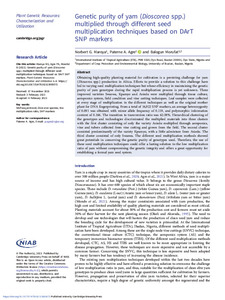| dc.contributor.author | Maroya, N. |
| dc.contributor.author | Agre, A.P. |
| dc.contributor.author | Balogun, M. |
| dc.date.accessioned | 2023-04-13T11:45:16Z |
| dc.date.available | 2023-04-13T11:45:16Z |
| dc.date.issued | 2023-04-04 |
| dc.identifier.citation | Maroya, N., Agre, A.P. & Balogun, M. (2023). Genetic purity of yam (Dioscorea spp.) multiplied through different seed multiplication techniques based on DArT SNP markers. Plant Genetic Resources: Characterization and Utilization, 1-6. |
| dc.identifier.issn | 1479-2621 |
| dc.identifier.uri | https://hdl.handle.net/20.500.12478/8127 |
| dc.description.abstract | Obtaining high-quality planting material for cultivation is a persisting challenge for yam (Dioscorea spp.) production in Africa. Efforts to provide a solution to this challenge have led to varying seed multiplication techniques but whose efficiency in maintaining the genetic purity of yam genotypes during the rapid multiplication process is yet unknown. Three improved varieties Swaswa, Kpamyo and Asiedu were multiplied through tissue culture, aeroponics system, field condition and vine cutting techniques. Leaf samples were collected at every stage of multiplication in the different techniques as well as the original mother plant for DNA fingerprinting. From a total of 16,922 SNP markers, an average heterozygosity of 0.091 was obtained with minor allele frequency of 0.119, and polymorphic information content of 0.166. The transition to transversion ratio was 62:38%. Hierarchical clustering of the genotypes and technologies discriminated the multiplied materials into three clusters with the first cluster consisting of only the variety Asiedu multiplied through aeroponics, vine and tubers collected from vine cutting and grown from the field. The second cluster consisted predominantly of the variety Kpamyo, with a little admixture from Asiedu. The third cluster consisted of only Swaswa. The different seed multiplication methods showed great potentials in conserving the genetic purity of genotypes used. Therefore, the use of these seed multiplication techniques could offer a lasting solution to the low multiplication ratio of yam without compromising the genetic integrity and offers a great opportunity for establishing a formal yam seed system. |
| dc.description.sponsorship | Bill & Melinda Gates Foundation |
| dc.format.extent | 1-6 |
| dc.language.iso | en |
| dc.subject | Yams |
| dc.subject | Dioscorea |
| dc.subject | Single Nucleotide Polymorphism |
| dc.subject | Genotypes |
| dc.subject | Tissue Culture |
| dc.title | Genetic purity of yam (Dioscorea spp.) multiplied through different seed multiplication techniques based on DArT SNP markers |
| dc.type | Journal Article |
| cg.contributor.crp | Roots, Tubers and Bananas |
| cg.contributor.affiliation | International Institute of Tropical Agriculture |
| cg.coverage.region | Africa |
| cg.coverage.region | West Africa |
| cg.coverage.country | Nigeria |
| cg.coverage.hub | Headquarters and Western Africa Hub |
| cg.researchtheme | Biotech and Plant Breeding |
| cg.identifier.bibtexciteid | MAROYA:2023 |
| cg.isijournal | ISI Journal |
| cg.authorship.types | CGIAR Single Centre |
| cg.iitasubject | Agronomy |
| cg.iitasubject | Food Security |
| cg.iitasubject | Genetic Improvement |
| cg.iitasubject | Plant Breeding |
| cg.iitasubject | Plant Genetic Resources |
| cg.iitasubject | Plant Production |
| cg.iitasubject | Yam |
| cg.journal | Plant Genetic Resources: Characterization and Utilization |
| cg.notes | Open Access Article; Published online: 04 Apr 2023 |
| cg.accessibilitystatus | Open Access |
| cg.reviewstatus | Peer Review |
| cg.usagerightslicense | Creative Commons Attribution 4.0 (CC BY 0.0) |
| cg.targetaudience | Scientists |
| cg.identifier.doi | https://doi.org/10.1017/s1479262123000072 |
| cg.iitaauthor.identifier | Norbert Maroya: 0000-0002-7079-4729 |
| cg.iitaauthor.identifier | Paterne AGRE: 0000-0003-1231-2530 |
| cg.iitaauthor.identifier | Morufat Balogun: 0000-0001-8770-5529 |
| cg.futureupdate.required | No |

